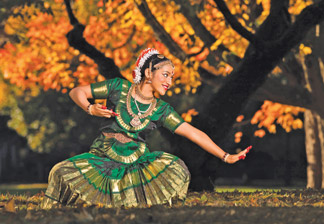Abinaya: an integral part in Indian classical dances
Subashini PATHMANATHAN
Abinaya plays a major role in certain Indian classical dance forms.
Abinaya means interpretation of the songs through hand gestures and
facial expression. The dancer expresses and expounds the manotharma of
the songs through bavas and rasas.
The essence of abinayas is called Bavas and the substance of Bava is
called Rasas. The concept of Bava can be seen not only in dance but also
one can feel it is in the way of singing in the vocal music. In olden
days the hereditary members of the Isai Vellala families who were
involved with music and dance well preserved the Bavas and Rasas
together in dance and music.
|
Essential abinaya
*Abinaya is a major role in Indian classical dance forms
*Essence of abinayas is called Bavas
*Ability of expression depends on the performer
*People are linked with each other through abinayas
*Imagination and creativity play a major role |
Through Abinaya in dance the dancer reaches the hearts of the
audience. In music through raga the tone and by way of singing the
musician reaches the hearts of the people. The ability in expressing
abinayas (bava and rasas) differs from individual to individual.
The abinayas were referred to by Adiyarku Nallar the commentator of
Sillapathikaram as ‘Molliya Moli’ which means language without language
only through expressions.
Through abinayas the people all over the world are linked together.
Handling abinayas is totally depended on the dedication experience and
involvements of the individuals with the art. As compared to Nirthya the
way of performing pure Nirtha is more technical and mechanical mainly in
the execution of adavus and poses.
In nirthiya personal ability imaginative creativity and experience
play a major role. Sathir (the earlier form of Bharatha Natyam) danced
by Nautch dancers used various subtle movements in dance by using lip
movements, eye movements and eye brow movements.
These Nautch dancers were called devadasis. The devadasis’ way of
interpretation of songs was almost the direct interpretation of the
meanings. But today in Bharatha Natyam the dancers mainly interpret the
songs invariably and indirectly through Sanchari bava.
The devadasis never used much Sanchari bavas. Each Indian classical
dance has its own unique style and standard. Most dances were solo
performances but with the passage of time all these dances were
performed as group dances. Bharatha Natyam, Mohini Attam, Kuchupidi,
Odissi and Kathakali are still performed as individual dances.
 |
|
Body
movement is part and parcel of Bharatha Natyam |
Many present day Bharatha Natya dancers study abinayas from the
Kuchupidi Kathakali and Bhgavatha Mela artistes. During the pre-Indian
independence period all the above said dance forms were only male dance
forms.
Abinayas of Kuchupidi and Kathakali are very rich. Still Kuchupidi
has more affinity with Bharatha Natyam. Originally Kuchupidi and
Kathakali were performed by males with exclusively expressions. There
was evidence that many devadasis and non devadasi dancers learnt,
abinayas nuances and mastered their abinayas skill under Kuchupidi
teachers.
There is a reference that the famed abinaya queen Balasaraswathi
learnt abinayas under Kuchupidi teacher. Even it was said that many
devoted non-traditional and outstanding dancers learnt abinayas under
Kathakali exponents. Even the creative dancer Udaya Shanker learnt the
nuances of abinayas under Kathakali exponents.
Later his creative dance form gained international recognition.
Odissi another Indian classical dance form has beautiful graceful
abinayas. All these traditional dance forms are deeply influenced by
religious themes and use variety of hand gestures to interpret the
meaning of the song. The hand gestures are used in all these dance forms
to expound the meaning of the songs through abinayas. |



